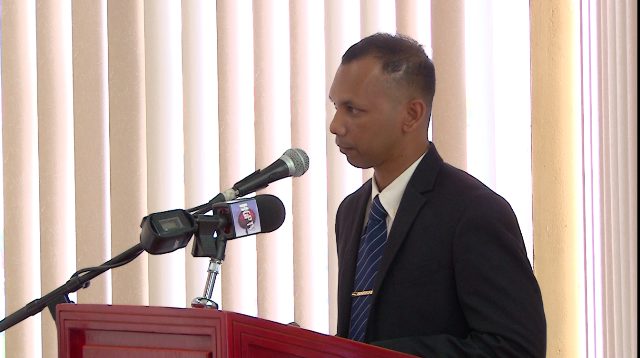More than 120 Customs Anti-Narcotic Unit (CANU) officers are expected to benefit from the agency’s annual training programme, which began yesterday with emphasis being placed on the need for an increase in capacity building.
Speaking at the opening ceremony, held yesterday morning at the Georgetown Club on Camp Street, Minister of Public Security Khemraj Ramjattan said the need for an increase in capacity building was one of the recommendations that was made in the 2019 United States State Department’s report on Guyana.
“…And so it is necessary that we also, as our resources can provide, do the capacity building that we are doing here today,” Ramjattan said.
He noted that for the year thus far, 32 officers have received training. In the last year, 95 officers were trained both overseas and locally.
Ramjattan also said the unit has recorded several major accomplishments over the past four years, including the construction of accommodation for ranks working at Cheddi Jagan International Airport (CJIA) in 2017, the construction of new headquarters, an increase in assets, an increase in strength by more than 140%, the opening of new locations in regions 2, 6 and 9, and a greater collaboration with local counterparts such as the Police Narcotics Branch and the Guyana Revenue Authority (GRA).
He noted the number of seizures over the past five years, ranging from 610 kilogrammes of cocaine in 2015 and 115 kilogrammes thus far for this year.
The increase in performance by CANU officers, Ramjattan said, has also led to the apprehension of persons in possession of ecstasy, heroine and crystal meth.
He urged the officers to understand their roles as the trade in narcotics is reaching over the trillion dollars level internationally.
“…This trading in this illegal substance, the entire empire surrounding it, almost every activity that helps it and follows it, is disastrous for the world….and we have to, within our units… ensure that we are with capacity to counter this trade and all its negative effects,” Ramjattan stated.
He further explained that the use of narcotics creates a lot more violence in society and causes corruption at almost every level.
“I want to tell you that it corrupts governments, it corrupts the commercial sector of a society, [and] it corrupts the law enforcement. This thing called drugs… the people behind it also do not care as to the consequences of what happens… all they care for is the profits,” Ramjattan noted.
Ramjattan related that the perpetrators are usually hard to identify because they are in “plain sight”.
Meanwhile, Deputy Head of CANU Lesley Ramlall said over the last year CANU has not only recorded a reduction in the flow of narcotics but also a decrease in the number of persons attempting to smuggle narcotics through the airports, especially during the July to August period.
Ramlall explained that coming out of an international drug enforcement conference held earlier this year, CANU was apprised that it is anticipated that from 2019 to 2020 there will likely be an “enormous” increase in the flow of narcotics globally.
Ramlall said those that are responsible for the cultivation, production and distribution of narcotics have already surpassed law enforcement’s expectations in terms of the quantity being produced in 2019.
He noted that unprecedented seizures are clear indicators that the demand for narcotics continue to increase.
“Looking at the situation in the Caribbean and which Guyana is considered a part of despite our geographical location, there has not been any significant seizures thus far for 2019 except for one in our neighbouring country in the east. However, we must be cautious of this since over the last eight years the amount of cocaine flowing through the Caribbean region has more than quadrupled, increasing from 35 metric tonnes in 2010 to 184 metric tonnes in 2018,” he explained.
In addition, he said the destruction of five fentanyl laboratories within the last three years in one country is a clear indication that the use of synthetic drugs is now a new but rapidly expanding phenomenon within the region. “And so it leaves us to ponder what should be the approach to such a trend,” Ramlall said.
Ramlall further noted that this year has seen an increase in the use of synthetic drugs, particularly ecstasy. “This dangerous and diabolical trend reiterates the need for greater inter-agency collaboration so as to ensure that our young generation is not lost,” he said.
Ramlall added that the theme for this year’s training is a continuation of last year’s since the unit believes that such measures will immensely enhance the counter-narcotics efforts.
During the week-long programme, which is being held under the theme ‘Stemming the flow of narcotics through capacity building and inter-agency collaboration,’ ranks are expected to be trained in areas such as leadership and professionalism, interviewing and search techniques, immigration operation, examination of documents and forensic awareness.





